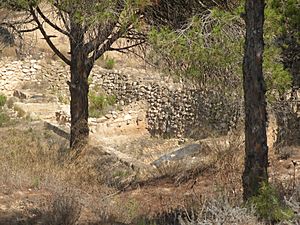La Fonteta Phoenician Port facts for kids
La Fonteta was an ancient port city built by the Phoenicians. It was located in what is now the town of Guardamar del Segura in Spain, specifically in the Province of Alicante. This city was very important for trade and life in the western Mediterranean Sea a long, long time ago.
Contents
A Busy Ancient Port
La Fonteta was a busy port city from the 8th century BC to the 6th century BC. It was built right on the mouth of the Segura River. Imagine a city that was about eight hectares big! That's like 16 football fields. This size makes it one of the largest and best-preserved Phoenician cities found in the western Mediterranean.
From the very beginning, La Fonteta had a special connection to a nearby holy place. This place, likely dedicated to Astarte, a goddess who protected sailors, was important for people traveling by sea. The city was eventually covered by sand dunes, which helped keep it safe and well-preserved for thousands of years. Because of this, we know La Fonteta was a very important Phoenician city during the 7th and 8th centuries BC.
Trade and Discoveries
People in this area were trading with the Phoenicians even before La Fonteta was built. Objects made of bronze, ivory, and glass found nearby show that trade started as early as the 9th century BC. This trade grew even more in the 8th century BC.
A place called Peña Negra, also near the Segura River, was known for making metal items in a style called "Atlantic." This likely attracted traders from the eastern Mediterranean. In 1983, a team of archaeologists found that Peña Negra was probably the "Herna" mentioned in an ancient text called the Ora Maritima. It was a thriving trading hub where many different trade routes met.
Strong City Walls
Archaeologists have uncovered about 60 m (200 ft) of the city's strong defensive wall. This wall was built from medium-sized stones like sandstone and limestone. It was between 4 and 5 m (13–16 ft) thick and might have been over 7 metres (23 ft) wide at its base!
The Phoenicians used a clever building method for this wall. They added strong supports, called buttresses, at regular spots. These supports were taller than the main wall. This design helped to stop movement, like from an earthquake, from shaking the entire wall and making it fall apart.
Everyday Objects and Art
Many different kinds of objects have been found at La Fonteta. Archaeologists have discovered lots of Phoenician pottery, including large storage jars called amphorae, plates, and decorated cups. They also found pottery with a red coating and shiny, polished surfaces, like plates with rims, bowls, special jugs called oenochoes, lamps, and tripods.
Besides Phoenician items, they also found pottery from ancient Greece. Some very interesting ritual objects were also uncovered, such as decorated ostrich eggs, pieces of ivory, and small carved stones called scarabs. These finds help us understand what life was like in this ancient city.
See also
 In Spanish: Ciudad portuaria fenicia La Fonteta para niños
In Spanish: Ciudad portuaria fenicia La Fonteta para niños


